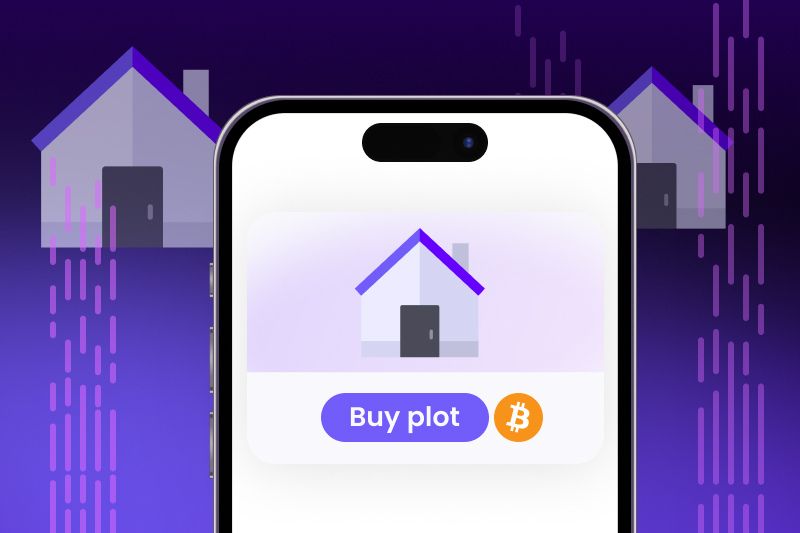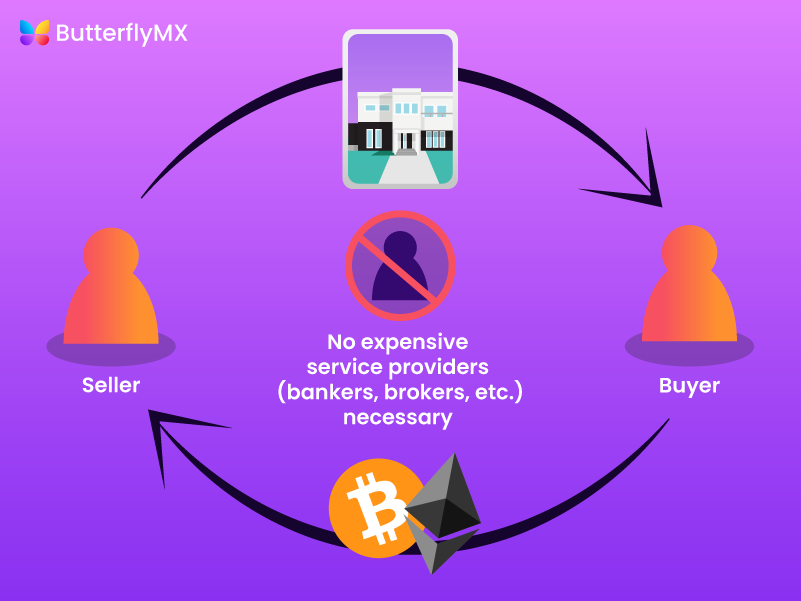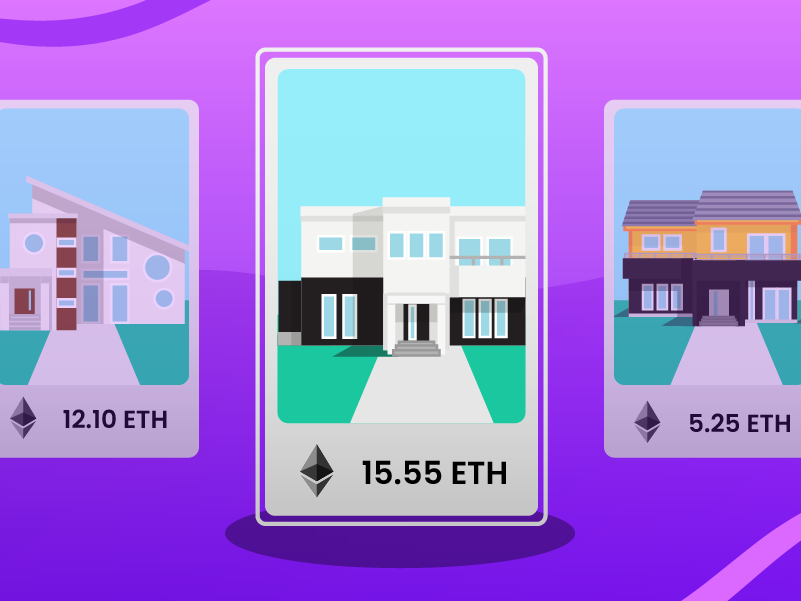Key takeaways
- Digital real estate is any virtual property that has monetary value.
- People buy digital property because it has value and provides new avenues for making money or achieving other goals.
- Digital real estate can be used to host virtual events, create content marketing campaigns, monetize websites with subscriptions and advertisements, flip websites for a profit, generate passive income streams, and more.
- Before investing in virtual property, research the digital real estate market, create a plan to monetize your investments, and stick with a thoughtful strategy.
- To get started in digital real estate, consider investing in blockchain-based technology, using cryptocurrency, and entering the metaverse.

Disclaimer: This content is for informational purposes only, you should not construe any such information as legal, tax, investment, financial, or other advice. Nothing contained on our site constitutes a solicitation, recommendation, endorsement, or offer by ButterflyMX or any third-party service provider. ButterflyMX is not a financial adviser. You should always seek independent legal, financial, taxation, or other advice from a licensed professional.
If you’re a savvy real estate investor, you’re always looking for the next big thing. And as much of life goes digital, so does real estate. There have been many interesting and exciting trends rising in the digital world — and one of them is digital real estate.
But is digital real estate investing worth it? Or is it going to be like the dot-com bubble of the 2000s? Read on to learn the essentials of digital real estate: what it is, how it impacts you, and how it’s shaping the future of real estate.
In this guide, we’ll cover:
- What is digital real estate?
- Why do people buy digital property?
- How to invest in digital real estate
- 4 digital real estate trends
- Implications for real-life real estate
- How to prepare for the digital transformation in real estate
- Digital real estate FAQs
What is digital real estate?
Digital real estate is virtual property — such as art, websites, and domain names — that has monetary value. So essentially, digital real estate is everything you see online related to real estate. It’s a virtual property that’s worth money. And much like traditional real estate, you can buy and sell these digital properties.
Just like with physical real estate, digital investors have the most essential tool to winning the money game: ownership. You can either purchase existing digital properties or build a new one from scratch.
These days, virtually everyone on the internet has heard of the metaverse. However, the metaverse — a combination of augmented reality and real-life experience — is merely one type of virtual real estate.
Examples of digital real estate
Technically, one example of digital real estate is social media sites like Facebook and Twitter are considered digital real estate. Similar to traditional landlords, owners of those platforms get paid when users “purchase space” to display their ads and other promotional content. The difference is that digital landlords don’t need to repair leaky faucets or ceilings.
Another example of digital real estate is very similar to how we view real estate properties in real life. Companies like Decentraland allow you to purchase acres of virtual land and invest in the metaverse. In late 2020, the first NFT real estate house — called the “Mars House” — was sold for over $500k.
As a reminder, NFTs are non-fungible tokens, which are a unique type of digital currency that’s not replicable. So, the Mars House was created in such a way that no other person could destroy or replicate it. Such data lives on the blockchain, a certain kind of database with secure encryptions that make it impossible to alter.
The intrinsic value of digital real estate derives from the fact that it’s a limited resource that can’t be reproduced. Think of the fact that there’s only one original copy of the Mona Lisa in the world. People use this same logic when evaluating NFT properties. And unlike cryptocurrencies such as Bitcoin, there exists only one copy of each NFT.
Who owns digital real estate?
In many cases, a virtual world platform — such as Sandbox, Decentraland, Cryptovoxels, and Somnium — owns the “land,” which they then sell to buyers.
Once a person or company purchases digital real estate, they get a “deed.” The “deed” (proof you own that property) lives on the blockchain as an NFT. Digital real estate owners can then sell their land by giving that NFT to the next buyer.
Why do people buy digital property?
People buy digital property because many digital and virtual properties are extremely valuable, especially for marketing and sales initiatives.
Just like with physical real estate, digital real estate is valuable because people want it. And people want it primarily because it creates new opportunities to make money or achieve other related goals.
How can digital real estate be used?
Digital real estate can be used to:
- Host concerts and virtual events
- Construct rental units and rent them out to companies that aren’t ready to buy metaverse real estate but want to try it out.
- Monetize websites, blogs, and other digital properties through advertising or subscriptions.
- Create content marketing campaigns to generate leads or referrals.
- Purchase existing websites with lots of traffic or large user bases.
- Generate passive income streams through affiliate programs, eCommerce stores and other online businesses.
Can you make money from digital real estate?
Yes, you can make money from digital real estate
Here are some ways to make money from digital property:
- Selling tickets to virtual events
- Building or buying websites
- Renting out website space (you’ll make money both from rental fees and the site’s capital appreciation)
- Advertising on other websites and blogs, or even in the metaverse
- Flipping domain names (i.e., buying a domain with high earning potential and selling it to a company)
- Buying virtual land, which may increase in value over time
- Buying and selling crypto and/or NFTs
How much does digital property cost?
The cost of digital property varies widely — anywhere from a few dollars to hundreds of thousands or even millions of dollars — depending on the type of property you want to purchase.
For instance, buying an existing website with a large user base or high traffic rates could cost tens of thousands of dollars. Alternatively, if you want to create a new website from scratch and monetize it with advertising or subscriptions, costs will likely be much lower. Additionally, some websites offer free hosting services that allow you to build your own sites without paying any upfront costs.
Ultimately, the cost of digital real estate depends on what kind of property you’re looking for and how much money you have available to invest.
Of course, when investing in digital real estate, it’s important to research and understand the market first. You should also consider the competition level within each type of property and make sure that you have a plan in place for how you’ll monetize your investment.
What is the highest paid digital real estate?
The highest paid digital real estate is the $4.3 million dollar purchase of an Atari property by Republic Realm, a virtual real estate owner and developer. This transaction took place on The Sandbox in February 2022.
How to invest in digital real estate
Investing in digital real estate can be a great way to generate income and build wealth. However, you don’t want to go into it blind.
Follow along with this overview of digital real estate investing for beginners:
1. Research the market
Before making a digital real estate investment, research the different types of property available and understand the competition levels in each type of asset. You should also consider the cost of these properties to ensure you have enough funds to cover your investments.
2. Create a plan
Once you’ve researched the market, you’ll need to create a plan for how you’ll monetize your investments.
Your digital real estate investing plan could be to:
- Use advertising or subscriptions to monetize websites
- Create content marketing campaigns to generate leads
- Flip websites for a profit
- Use affiliate programs and eCommerce stores
- Buy land in the metaverse
How to buy land in the metaverse
If your plan is to buy land in the metaverse, familiarize yourself with the process before you dive in.
The process of buying metaverse land depends on the platform you use, but here’s a general overview:
- Choose your platform. Digital real estate investing beginners may want to opt for a popular platform like The Sandbox or Decentraland.
- Set up a crypto wallet. Make sure whichever wallet you choose is compatible with the platform you’ve chosen.
- Use crypto to buy a plot of land. Check out the “neighborhood” and choose a plot. If the seller accepts your offer, you’re all set.
3. Be strategic
To maximize your profits, make sure you’re adhering to a well-thought-out strategy.
For example, if you’re flipping websites, you’ll want to choose which domains you buy carefully. Make sure there’s serious potential for value in terms of the domain name. You’ll also want to invest time and money into SEO and website design to maximize your digital property’s visibility.
Alternatively, if you plan to buy plots of land in the metaverse, be thoughtful about which platforms you buy on. Little-known metaverse platforms may offer cheaper plots but may be riskier or less secure.
Pros & cons of digital real estate investing
Pros:
- Potential for a high return on investment (ROI)
- Low overhead costs compared to traditional real estate investments
- Portfolio diversification
- Leverage new technologies such as blockchain and AI
- Rapidly growing markets with lots of potential for growth
Cons:
- Digital real estate prices can be unpredictable and subject to market volatility
- Potential scams or other fraudulent activities
- Lack of regulation, which can create a risky environment for certain types of investments
Watch how ButterflyMX works:
4 digital real estate trends
Ready or not, the digital real estate revolution is already underway. To prepare for this virtual reality, keep up-to-date with the latest trends in digital real estate. Not only will this inform you how to invest in metaverses, but it will also help you reevaluate your real-life property investments.
The top four trends in digital real estate are:
1. Decentralized finance
DeFi — which stands for “decentralized finance” — refers to a series of blockchain-based financial services to automate workflows for financial decisions. The ‘’decentralized” aspect of it comes from the fact that there are no people at the head of a DeFi service. Instead, smart contracts — a set of programmed rules on the blockchain — administer such services.
For the past decade, we’ve been moving towards DeFi. For instance, money is already digital. In fact, only 8% of the world’s currency is physical cash.
And in digital real estate, DeFi is at the core of every transaction. Traditional real estate is notoriously not transparent about a property’s transaction history, so owners and investors can jack up prices when selling. But with decentralized finance, every transaction of an NFT property is publicly available, so it’s nearly impossible to game the system.
This is all to say that digital real estate uses DeFi services to be more accessible and honest to the masses.
2. Tokenized asset sales
In traditional real estate, there are a lot of middlemen involved in the investment and sales processes. Additionally, a sole investor must hold their investment throughout the project’s full term. They only get their return on investment when they decide to refinance or sell the property. And throughout the process, multiple brokers, transfer agents, and service providers collect fees and manage operations.
At the end of the day, all this results in settlements that take several days, have high transaction costs, and offer very limited real-time pricing information.
But in digital real estate, assets are tokenized, meaning that they live on the blockchain. This results in a streamlined, automated process that improves trade speeds, enhances transparency for pricing information, and eliminates the need for expensive service providers.
What’s more, tokenization means that multiple people can buy tokens of a particular property and co-own the building, allowing fractional or partial ownership of the asset. Tokenization also allows digital real estate assets to be a more liquid commodity, meaning that owners can easily buy or sell their shares cheaper and faster. Therefore, this process attracts more potential investors and buyers in the real estate market by democratizing and decentralizing it.

3. Personalization & individuality
From building properties from the ground up to designing avatars, folks in metaverses have the power to create a world that’s entirely personalized to their liking. And since users have the autonomy to design the world of their dreams in metaverses, this gives companies and brands exclusive access to consumer demands. As a result, they can develop and advertise goods and services tailored to individual needs and desires.
In a sense, metaverses allow users to return to the purest version of their childhood — where their imaginations roam free and anything is possible. And brands entering these digital spaces are taking advantage of this immersive customization experience.
This also may have significant implications for real-life real estate properties. Metaverses could give real estate developers and architects real-time insights into which building designs and amenities tenants really want.
Essentially, virtual spaces can act as crowdsourced renderings of real estate properties that could eventually exist in the real world. The best part is that developments in digital real estate occur instantaneously, so developers and investors gain valuable insight as events unfold in real-time.
4. Focusing on location
As a result of the global Covid pandemic, people had the newfound ability to move anywhere they wanted because they didn’t have the constraints of having to go to a physical location for work or school.
And this extends to the digital landscape. However, instead of gravitating towards the suburbs — a strong trend we’ve witnessed in real life in recent years — the most popular properties in metaverses are in downtown districts.
Specifically, the more content a metaverse has, the busier it is and the more it’s worth. And similar to real life, digital properties in those areas are much pricier than surrounding “suburbs.” So, developers of these virtual spaces are paying close attention to the architecture and personality of particular sections of each metaverse.
Implications for real-life real estate
Why in the world should you care about digital real estate if you’re a real-life real estate investor?
Well:
There are a handful of valid reasons. For one, as the world continues to work remotely and depends heavily on digital assets to perform routine activities, the future will become increasingly digital. And real estate is certainly not exempt from this reality.
And as the general public becomes increasingly immersed in metaverses, getting involved with digital real estate might be an excellent way to diversify your portfolio. Although there are high price points of entry, there are plenty of affordable starting points. And if you find the most opportune time to invest in digital land, it could maximize your ROI when you sell it at the highest value point.

Second, as the digital metaverse becomes more of a norm, the gap between virtual and reality shrinks. The things people buy in metaverses are often the very same things they do in reality. So as a digital real estate investor, you could use these platforms to gain real-time insights on the latest trends before investing in them in real life.
Lastly, the price of digital land is now comparable to that of actual land. For example, Republic Realm, a virtual real estate company, recently sold virtual private islands for $300,000 each.
How to prepare for the digital transformation in real estate
The digital and real-life worlds are merging. These concepts aren’t just reserved for sci-fi movies like The Matrix or Ready Player One. And just like how the pandemic has expedited the mass work-from-home adaption, the same may happen for NFT virtual real estate.
So:
How does this translate into tangible actions you can take now to prepare for the digital real estate transformation?
We’ve got a couple of suggestions:
- Invest in blockchain-based technology
- Collect and send payments in cryptocurrency
- Enter the metaverse

Invest in blockchain-based technology
The simplest way to prepare for the inevitable digital transformation in real estate is to invest in proptech. Doing so will help your property adapt more quickly to the blockchain-enabled future.
Since the Internet of Things already powers proptech devices like video intercoms and smart locks, you can easily transfer most resident and property information onto a secure blockchain. Plus, residents will rest assured that their sensitive information is protected and safeguarded on a blockchain — much more than they currently are on standard online databases.
Even more, blockchain-enabled proptech devices and property management systems will be integrated and operate under the umbrella of one database.
As such, all devices can communicate and verify information instantaneously amongst themselves without additional programming. This allows you to seamlessly integrate all the moving parts of real estate.
Collect & send payments in cryptocurrency
Credit cards eliminated the need for cash, and digital wallets (i.e., Apple Pay and Google Pay) eliminated the need for physical credit cards.
So what’s next?
Cryptocurrency might take over digital wallets.
Online data privacy is becoming a prominent issue as we continue immersing ourselves in the digital world. So, don’t be surprised if more and more people want an extra layer of security for the currency itself to prevent fraud. Since cryptocurrency is decentralized, people may feel safer using crypto when paying with virtual credit cards, especially for big transactions like real estate investments or even rent payments.
Enter the metaverse
The truth is that the whole digital real estate phenomenon is still new. There are a lot of unknowns and uncertainties. But in some sense, that’s the best part of it.
As an early investor or owner, this means that you have a significant say in how the future of metaverses unfolds.
You don’t have to start big. Who knows: Perhaps a lesser-known metaverse of today will be the hottest place on the market tomorrow. And entering the metaverse could offer you valuable insights into consumer behavior that can easily translate into real-world investment.
Over a decade ago, people were highly skeptical of the foreseeable success of social media platforms. But look at how much influence and impact those platforms have today. Metaverses could very well have the same trajectory, especially as augmented and virtual reality technologies become increasingly robust and ubiquitous.
Digital real estate FAQs
What is digital property?
In relation to digital real estate, a digital property is another term for digital real estate. It’s often used to describe a single asset, rather than an entire portfolio.
How much does it cost to get into digital real estate?
The cost to get into digital real estate depends on what you’re buying. On average, a domain name costs between $2 and $20 per year. However, if you’re buying digital real estate in the Metaverse, you can expect to spend upwards of $5,000 per year. The prices vary widely.


